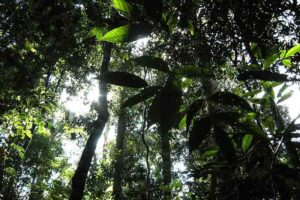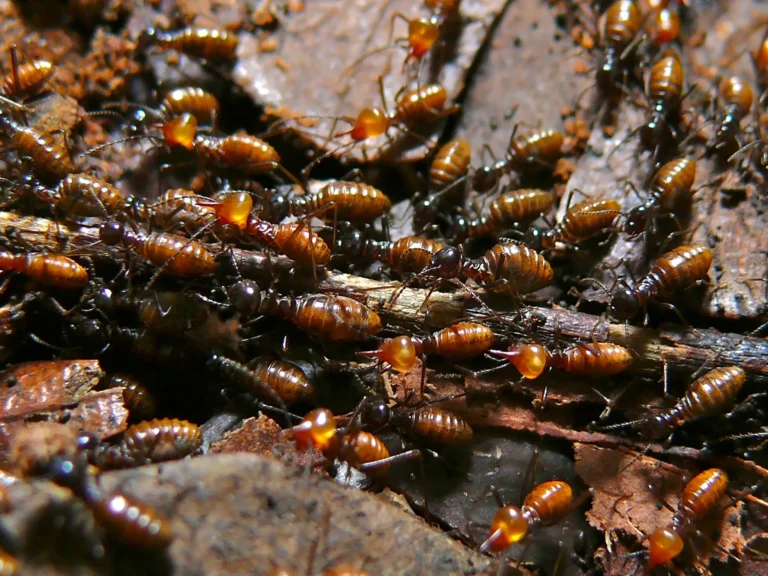13 Tropical Rainforest Facts Discussed
Tropical rainforest facts range from biogeochemical and socioeconomic to sociocultural, edaphic, climatic, biological and comparative concepts that describe the biome's nature; history; functions, relevance, and future prospects.
This article discusses facts about the tropical rainforest, as follows;
1). The Global Oxygen and Carbon Cycles are Significantly Influenced by Tropical Rainforests (as one of the Tropical Rainforest Facts)
With their abundant biotic and abiotic resources, tropical forests are crucial to not only the carbon cycle, but also to the oxygen cycle at a global scale.
In the process of photosynthesis, rainforest plants capture atmospheric carbon dioxide, and utilize it for the production of biomass; with oxygen as a byproduct.
Rainforests constitute an immensely capable carbon sink due to the large amount of vegetative biomass which they contain.
Some analyses have estimated that tropical forests produce up to 20% of total oxygen on Earth.
Soil and vegetation in the tropical rainforest, are sites of large-scale carbon sequestration.
Given that carbon dioxide is a greenhouse gas, its capture and utilization by rainforest trees can be considered influential toward global climatic conditions. This is why deforestation has been linked to climate change and general environmental degradation at all levels.
2). Tropical Rainforests have the Highest Biodiversity of All Terrestrial Ecosystems
One of the most well-known facts about the tropical rainforest is its immense biodiversity.
Tropical rainforest is the highest among terrestrial ecosystems on Earth, in terms of species richness and diversity [7].
In spite of their relatively-small areal coverage (compared to the Earth's total land area), tropical rainforests play host to over 50 percent of animal and plant species on Earth. This includes various insects, reptiles, amphibian, mammals, birds, plants, and even aquatic organisms (in aquatic microhabitats like lakes and ponds).

There are multiple factors that account for the high biodiversity in tropical rainforests, including;
1. Non-extreme (warm) temperatures
2. Sunlight availability
3. High amount of rainfall
4. Highly-evolved trophic relationships
5. Abundance of micro-habitats
A summarized way of presenting this factors would be an acknowledgement of the complexity of tropical rainforests and how this leads to ecologic fortification, resilience and sustainability, with less risk of resource-depletion than less-complex ecosystems like deserts and tundras.
Because plants and animals of the tropical rainforest have evolved in close contact with each other, they have developed highly reliable adaptive relationships including mutualistic symbiosis, predation and parasitism; all of which are essential to their survival and further evolution.
Flowering plants, for example, rely mutually on insects and birds as pollinators; providing food to these organisms in the process [4]. Several forest plants rely on other plants for structural support during growth, as well as for nutrients (in a parasitic setting).
The same can be said of relations between herbivores and vegetation, as well as between prey and predators. These relations build out to form stable food chains and webs.
There are various benefits posed by the immense biodiversity of tropical rainforests.
These include their role in increasing the scope and depth of scientific knowledge through exploration, analysis and documentation.
Studies of tropical rainforest species have brought insight to the mechanism and history of evolution.
Other benefits of tropical rainforest species range from agricultural to pharmaceutical, so that the preservation of such biodiversity is essential for the continuity of life as a whole, on Earth.
3). The Amazon is the World's Largest and Most Renowned Tropical Rainforest (as one of the Tropical Rainforest Facts)
The world's most iconic, as well as largest tropical rainforest is the Amazon; which occupies an area of about 6.7 million square kilometers [2].
The Amazon rainforest stretches across the land area of up to nine South American countries, and is mostly associated with Brazil, where it appears to have the strongest representation.
Because its immense contribution to the global oxygen-cycling and carbon sequestration mechanisms, the Amazon is sometimes described as the "lungs of the Earth" [6].
One of the outstanding attributes of the Amazon is its incredible diversity; which includes several thousands of bird, fish, and plant species.
Some of the organisms endemic to the Amazon are not found in any other tropical rainforest or terrestrial biome on Earth.
Animals commonly associated with this rainforest include macaws, sloths, anacondas and jaguars.

In addition to its status as an ecological edifice and resource-base, the Amazon has sociocultural significance to indigenous people and communities whose generational history is tied to the region occupied by this forest.
Some threats are however faced by the Amazon, including extensive deforestation [10].
The main driver of such deforestation is agriculture; where the expansion of land for farming is closely tied to higher rates of logging and forest land-loss.
Urbanization, mining, and general industrialization also pose threats to the Amazon.
Given its magnitude and composition, the gradual loss of the Amazon tropical rainforest has huge economic and social implications, as well as rippling environmental impacts especially with regards to climate change.
Various efforts at conservation, remediation and reforestation have been made to protect and preserve the Amazon.
4). Multiple Micro-habitats Occur in the Tropical Rainforest
As a result of its robustness, diversity and complexity; the tropical rainforest encompasses multiple micro-habitats in its land area.
Micro-habitats are formed due to spatial variations in abiotic and biotic conditions and parameters like;
1. Organic distribution
2. Soil composition
3. Humidity
4. Light availability
These variations lead to the creation of niches with differences in conditions and organic inhabitants.
*Vertical Stratification and the Creation of Rainforest Micro-habitats
A major cause of micro-habitat formation in the tropical rainforest is vertical stratification of vegetation.
Because of differences in height of plants, the overall forest structure can be seen as a series of vegetative layers or levels that include the forest floor, understory layer, canopy layer, and emergent layer.
In each layer, the conditions and available resources are distinctive from other layers.
The emergent layer is made up of sparsely-spaced, tall trees, and serves as a habitat for insects, high-climbing primates, and birds that are tolerant of heights and solar exposure.
Underlying layers like the canopy layer, are more dense in terms of vegetative biomass; and support animals like birds, some mammals and reptiles that are tolerant of the shaded conditions.
In the understory, light availability is low [8], due to obstruction by vegetation in overhead layers.
This layer is a micro-habitat that hosts shade-tolerant species of amphibians, reptiles, small mammals and plants.
On the forest floor, another organic community occurs, which comprises of decomposers, insects, ground-dwelling mammals, reptiles, and soil-dependent invertebrates.
*Other Micro-habitats in the Tropical Rainforest
Asides vertically-stratified layers; other micro-habitats in the tropical rainforest include those created by organic seclusion, and those occurring in aquatic systems like streams, rivers, lakes and ponds.
Organically-secluded micro-habitats occur around fallen logs, in leaf litter, and in tree-hollows, among others.
For aquatic micro-habitats, they play host to fish, amphibians, some reptiles, and aquatic plants.
Leaf litter and fallen logs create suitable micro-habitats for decomposers and detrivorous feeders like beetles, earthworms, fungi and bacteria. Tree hollows may host small mammals, birds and insects.

As earlier stated, micro-habitats in the tropical rainforest contribute to the enhancement of its biodiversity. These micro-habitats each host unique species, which interact with species from other micro-habitats to establish resilient ecologic dynamics that further support continuity and speciation.
5). Tropical Rainforests Occupy only a Small Percentage of Earth's Total Land Area, in Equatorial Zones (as one of the Tropical Rainforest Facts)
In spite of their diversity and ecologic importance, tropical rainforests cover a relatively small area/percentage of the total land on Earth.
Generally, they are confined to a humid belt around the equator, lying between the Tropic of Capricorn and the Tropic of Cancer [9].
The precise areal coverage of tropical rainforests on Earth is constantly changing due to deforestation and vegetation growth-dynamics; however it is at least 6 percent of the total land area.
*Areal Coverage and the Geographic Limitation of Tropical Rainforest
The main reason for the geographic confinement of tropical rainforest biome, is the requirement of specific climatic, geologic and biological conditions for the origination and continuity of such forests.
Areas where tropical rainforest can thrive are those with warm temperatures and high rainfall levels, all year round. These conditions are necessary to support the growth of vegetation that forms the rainforest structure.
They also support the survival and trophic interactions of animals that are endemic to the rainforest.
*Environmental Conditions and Their Role in the Sustenance of Tropical Rainforests
In equatorial zones like those that host tropical rainforests, climatic conditions are relatively stable, so that there is very minimal seasonal fluctuation in temperature, humidity, or precipitation.
This stability of the tropical rainforest climate, accounts for the sustenance and thriving of its species.
It establishes conditions favorable for seed dispersal, pollination and general metabolism; all of which are behind the resourcefulness and high productivity of the biome.
Because of their complexity and resilience, tropical rainforests are influential toward many of the Earth's trends and conditions, in spite of their small areal coverage. This differentiates the tropical rainforest from other large biomes like deserts and tundras, that are less biologically-robust or complex.
6). Large Indigenous Populations Depend Directly on Tropical Rainforests for Survival
Tropical rainforests are important for the survival of indigenous communities that live within their terrain, and whose origins, economies and cultures bear links to the biome.
For these populations, the tropical rainforest is a symbol of social cohesion, cultural and customary continuity, and a source of various resources.
*Indigenous Communities as Dependents on the Tropical Rainforest
Indigenous populations that inhabit equatorial regions, depend on the tropical rainforest for several of their needs including food, medicine, energy (like heat from burning fuel-wood), and shelter.
Plants and animals from the rainforest are food sources to these communities, which are knowledgeable on the resources of the forest, and contribute to its continuity through various sustainable practices.
Activities like agroforestry-farming, fruit-gathering, and hunting, signify the interaction between the human population in these indigenous communities, and the forest.
*Resources from the Tropical Rainforest that are Used by Indigenous People
Materials provided by tropical rainforests include those for making local tools and building traditional structures.
Different handcrafts, locally-constructed dwellings, and tools are created using these materials, by indigenous populations whose knowledge of the forest enables them access the best-suited materials and utilize them in the most optimal manner.

Tropical rainforests also provide raw materials that can be used as traditional medicine by indigenous people.
Such medicinal materials have been used for generations in the treatment of a broad range of illnesses.
Lastly, indigenous communities utilize rainforests as components of their culture in both social and religious contexts. For them, the rainforest is often a sacred entity that constitutes part of their customary behaviors, rituals and beliefs.
7). Most of Tropical Rainforest Life Occurs in its Vegetation (as one of the Tropical Rainforest Facts)
Tropical rainforest vegetation serves as the main foundation and epicenter of all organic life and biological processes that occur in this biome.
With its abundance, diversity and density, the vegetation accounts for the intricate and robust food webs that are occupied by various animal and plant species.
*Vegetative Layers in the Tropical Rainforest and Their Associated Organic Populations
Distinct strata or vegetative layers are characteristic of rainforest vegetation, where each of these layers supports an assemblage of unique species.
Epiphytes, monkeys, and bird species are all found in the canopy layer of the rainforest, which consists of several tall trees that constitute a continuous cover of leaves and branches, obstructing a significant amount of light (from the Sun) from reaching the forest floor.
The understory lies below the overhead canopy, and is made up of shrubs, saplings; and relatively-short trees. Its vegetation is shade-tolerant, and its shelters several organisms.
Plant material also occurs on the forest floor, which is the most-shaded segment of the tropical forest, across its vertical profile.
Fallen leaves, branches and low-growing plants (both vascular and non-vascular) nay be found on the forest floor.
In addition to forming micro-habitats, rainforest vegetation serves as the primary food source in this biome; which is consumed by herbivores that in turn serve as food sources for carnivores and some omnivorous rainforest animals.
The analogy in this section shows that animal diversity and abundance in the tropical rainforest, are reflective of the diversity and abundance of plants.
8). Solar Radiation is Restricted in Tropical Rainforests by the Forest Canopy
A distinctive attribute of tropical forests is its canopy, which is a dense sequence of vegetative layers that occupy a large portion of the area in this biome.
The network of foliage and branches that makes up this canopy, serves as a barrier and is effective at restricting the amount of solar radiation reaching the underlying layers and forest floor.
*Implications and Mechanism of Light Obstruction by Tropical Rainforest Vegetation
Vegetation in the rainforest canopy interacts with sunlight in an obstructive manner, causing the scattering, deflection and diminishing of such light.
This vegetation can be described as playing the role of an organic filter that ultimately reduces light intensity, so that less solar radiation enters the forest than that which is incident on the forest from the Sun.
Some of the implication of this diminishing interaction are positive.
By obstructing solar-electromagnetic waves; the tropical forest canopy prevents excessive heat from building-up in the underlying layers.
It also prevents extreme degrees of temperature fluctuation that can make it difficult for several species to adapt.
The low light-penetration at all times of the day makes tropical rainforests to be aesthetically stable; which, alongside stable temperatures, is an advantage for many organisms.

*Implications of Limited Light Availability for Tropical Rainforest Plants
The restriction of solar radiation in tropical rainforests, has implications toward plant growth.
These implications are not entirely positive, since plants depend on sunlight for photosynthesis and growth.
However, shaded conditions have also led to the evolution of plant species that are shade-tolerant, and capable of thriving in spite of low light-intensity.
For such plants, the ability to thrive with low light supply can be attributed to adaptive features like enhanced solar efficiency, large leaves, and resource conservation.
Competition for light has also played a role in vertical stratification of rainforest plants, with the most competitive plants developing growth patterns and physiological features to improve their access to sunlight.
*Sunlight Restriction and Moisture in the Tropical Rainforest
Water conservation, consistent humidity and moisture levels in the tropical rainforest can all be traced to the limited entry of solar rays.
Evaporation rates are not excessively high because the interior of the tropical rainforest is not exposed directly to solar radiation. This prevents rapid water loss that can cause low humidity.
The vegetative layers themselves also enclose water vapor within the forest, preventing escape of such vapor into the upper atmosphere, and causing the interior of the forest to remain humid at all times of the year.
This mechanism creates favorable conditions for the survival of diverse animals and plants.
9). Tropical Rainforests have One of the Highest Amounts of Precipitation Among Ecosystems (as one of the Tropical Rainforest Facts)
As the name implies, the tropical rainforest is renowned for its abundant rainfall, which is higher than precipitation-levels in several terrestrial ecosystems.
Factors that can account for the high amounts of rainfall in tropical rainforests include regional water bodies, convective wind-dynamics, air-humidity, and relatively-high temperature.
*Geographical Influence and Tropical Rainforest Precipitation
In terms of geographical location, the equatorial position of tropical rainforests is a huge contributor to precipitation.
Due to the orientation of the equator relative to the Sun at most times of the year, equatorial areas are susceptible to the influence of warming on hydrological and aerodynamic processes.
*Mechanism(s) and Factors Behind Rainfall in the Tropical Rainforest
Moist air is circulated continuously in convective currents that are driven by density differences caused by alternate heating and cooling of air masses [3].
Warm, moist air is less dense than cool air, and rises under the influence of gravity. As it ascends high into the atmosphere above equatorial zones, it cools and its vapor-content condenses to produce rain.
The large areal span, and abundant vegetation of tropical rainforests also contribute to high precipitation within their environs.
Tropical rainforests produce significant amount of water vapor through evapotranspiration, and the microclimatic conditions created by forest vegetation help facilitate cloud formation and rainfall.
*Implications of Tropical Rainforest Precipitation
Abundant precipitation in the tropical rainforest has biotic and abiotic implications.
The dense vegetation that is typical of tropical rainforests is an outcome of sufficient water supply, which comes mostly from rainfall.
This vegetation in turn supports a diverse array of animal and plant species, that also benefit from precipitation in terms of creating a favorable climate for growth and reproduction.
Non-positive effects of rainfall include the risk of soil-leaching, although this risk is reduced by the presence of vegetative layers that obstruct rainfall and minimizes direct contact with the forest floor.
10). Millions of Hectares of Tropical Rainforest are Lost Annually
Deforestation is arguably the most significant environmental issue affecting the tropical rainforest, with South America alone being recorded to have lost up to 4 million hectares per annum [1].
The continuous loss of such immense resources in the form of forest land and biodiversity, has economic, social and environmental consequences, which have added to the severity of this phenomenon.
*Causes of Deforestation in Tropical Rainforest Zones
1. Agricultural Development as a Driver of Tropical Deforestation
Multiple factors can be considered drivers of tropical rainforest deforestation.
One of the most prominent of these is agricultural development (and expansion); which is most notable in areas where demand for agricultural products is fueled by socioeconomic factors like overpopulation and economic changes.
Increase in the demand for soybeans, timber, beef, and palm oil among other food products is behind the rapid rate of conversion, of forest land to agricultural land.
Commercial agriculture on a large and growing scale, is practiced in equatorial regions as part of necessary economic development to support an equally growing population.
Ranching, plantation-farming, and all forms of agricultural industrialization have led to the clearing of vast forest areas and removal of native plants, which causes indigenous animal species to be displaced.

2. Logging as a Cause of Tropical Rainforest Depletion
Another huge contributor to deforestation in tropical rainforest areas is illegal logging.
High-quality timber is the target of illegal loggers, who exploit rainforests to acquire this raw material for commercial purposes.
Extensive logging without legal restrictions or sustainable approach, leads to the fragmentation of natural habitats, loss of valuable species of trees, increase in wildlife vulnerability, and disruption of ecological dynamics.
3. Urbanization and Infrastructure Development as Drivers of Tropical Forest Depletion
Infrastructure development and urbanization projects that involve civil structures like power plants, buildings and roads; are all linked to deforestation in regions where tropical rainforest occurs.
Such projects convert remote lands to sites of economic activity and/or human settlement, and facilitate further degradation and fragmentation as these human activities and settlements expand.
*Effects of the Loss of Tropical Rainforests
The effects of deforestation are immense.
Loss of rainforest vegetation can disrupt the natural trend of ecological processes and functions, like water conservation, organic speciation, and carbon sequestration.
Other environmental problems can arise from deforestation as well, such as climate change; through the release of large amounts of carbon dioxide into the atmosphere, and the reduction of carbon storage capacity on the Earth's surface.
Animal and plant species lose their natural habitat when rainforests are degraded.
The risk of soil erosion also increases significantly on a regional scale, posing a threat even to agriculture (which is one of the drivers of deforestation) and threatening human livelihood within local communities.
*Possible Measures to Address Deforestation and Loss of Tropical Rainforests
To address deforestation, a multi-dimensional approach is generally required.
Measures that can be included in this approach are;
1. Sustainable farming practices with land conservation
2. Creation and enforcement of environmental laws protecting forested areas
3. Large-scale reforestation
4. Sustainable resource management
11). Soil in the Tropical Rainforest is Typically Low in Nutrient-Content (as one of the Tropical Rainforest Facts)
Soil in tropical rainforests, is typically low in its nutrient composition [5].
The condition of tropical rainforest soil can be seen as a result of long-term evolution under a set of unique ecologic conditions and processes.
*Factors Contributing to the Low Fertility of Tropical Rainforest Soil
1. Leaching as a Result of Warm Temperatures and High Rainfall
Warm temperatures and high rainfall in tropical rainforests are contributors to the condition of the soil.
These factors facilitate rapid physical and chemical weathering of soil minerals.
Rainwater that reaches the forest floor dissolves and translocates nutrients like magnesium, phosphorus, potassium and calcium from to upper soil layers where they can be accessed easily by plants, to lower soil layers.
This is called leaching, and results ultimately in resource-depletion from the soil.
2. Abundant Vegetation as a Driver of Low Soil Fertility in Tropical Rainforest
The dense and abundant vegetation of tropical rainforests may contribute to soil infertility, by establishing an active loop of nutrient cycling that confines most of these nutrients to the living cells of plants.
Plants in tropical rainforests survive through rapid uptake of nutrients from their environment, so that there is little left to accumulate in soil.
This is compounded by the rapid rate of biodegradation of plant and animal remains on the forest floor, and the leaching of what nutrients are derived from such decomposition.
The outcome of these factors working in unison, is a rapid rate of nutrient turnover in the ecosystem, where plants (and animals) are constantly in use of the available resources, with little left for storage.
3. Organic Competition as a Cause of Tropical Rainforest Soil Condition
The abundance of life in tropical forests, places plant and animal species in a state of constant competition for resources.
Dense vegetation places high demand on the ecosystem for nutrients to support its continued growth, so that essential elements are taken up rapidly and efficiently as soon as they are made available (from decomposition of biomass).
This is one of the factors behind rapid nutrient cycling that leaves rainforest soils with low fertility.
12). Average Temperatures are Relatively High within the Vicinity of Tropical Rainforests
High temperatures all year-round represents a well-known characteristic of tropical rainforests, so that they are one of the warmest biomes on Earth.
*Geographic Location as a Contributor to the Warm Temperatures of Tropical Rainforests
The equatorial location of tropical rainforests plays a major role in their warm nature.
In these equatorial regions, solar thermal radiation is relatively abundant, leading to heating of the Earth's surface and the atmosphere, which results in high temperatures.
*Rainforest Canopy and Elevated-Temperature Condition
Temperature regulation in the tropical rainforest is also affected significantly by the dense vegetative canopy.
This canopy intercepts and absorbs large amounts of solar radiation by acting as a barrier between the atmosphere and the forest floor.
The shade provided by rainforest canopies helps to prevent excessive heat from building up within the forest's micro-habitats; while maintaining relatively high temperatures in the forest (through its heat absorption/energy storage function).
*Humidity as a Driver of High Temperature in Tropical Rainforests
High levels of humidity in tropical rainforests, facilitate warm air temperatures because of the absorption of heat by water vapor.
Because of the dense vegetation, evaporation (along with its cooling effect) is restricted within tropical rainforests. This results in retention of warmth for extended periods of time.
13). Tropical Rainforests Have a Complex Vegetative Structure that Facilitates the Establishment of Microclimate (as one of the Tropical Rainforest Facts)
Tropical rainforests are known for their dense, complex vegetative structure that includes multiple layers.
This structure is behind the diversity of the biome, and its containment of multiple microhabitats and micro-climatic conditions.
Conclusion
Tropical rainforest facts are;
1. The Global Oxygen and Carbon Cycles are Significantly Influenced by Tropical Rainforests
2. Tropical Rainforests have the Highest Biodiversity of All Terrestrial Ecosystems
3. The Amazon is the World's Largest and Most Renowned Tropical Rainforest
4. Multiple Micro-habitats Occur in the Tropical Rainforest
5. Tropical Rainforests Occupy only a Small Percentage of Earth's Total Land Area, in Equatorial Zones
6. Large Indigenous Populations Depend Directly on Tropical Rainforests for Survival
7. Most of Tropical Rainforest Life Occurs in its Vegetation
8. Solar Radiation is Restricted in Tropical Rainforests by the Forest Canopy
9. Tropical Rainforests have One of the Highest Amounts of Precipitation Among Ecosystems
10. Millions of Hectares of Tropical Rainforest are Lost Annually
11. Soil in the Tropical Rainforest is Typically Low in Nutrient-Content
12. Average Temperatures are Relatively High within the Vicinity of Tropical Rainforests
13. Tropical Rainforests Have a Complex Vegetative Structure that Facilitates the Establishment of Microclimate
References
1). Chakravarty, S.; Ghosh, S. K.; Suresh, C. P.; Dey, A. N.; Shukla, G. (2012). "Deforestation: Causes, Effects and Control Strategies." Global Perspectives on Sustainable Forest Management. Available at: https://doi.org/10.5772/33342. (Accessed 22 June 2023).
2). Constantino, L. (2022). "Fire in the Amazon is associated more with agricultural burning and deforestation than with drought." Available at: https://phys.org/news/2022-11-amazon-agricultural-deforestation-drought.html. (Accessed 23 June 2023).
3). Constantino, L.; Heinrich, P. (2014). "Tropical deep convection and density current signature in surface pressure: comparison between WRF model simulations and infrasound measurements." Atmospheric Chemistry and Physics 14(6). Available at: https://doi.org/10.5194/acp-14-3113-2014. (Accessed 23 June 2023).
4). Grant, E. L.; Wallace, H. M.; Brooks, P. R.; Burwell, C.; Reddell, P. W.; Ogbourne; S. M. (2021). "Floral attraction and flower visitors of a subcanopy, tropical rainforest tree, Fontainea picrosperma." Ecol Evol. 2021 Jul 7;11(15):10468-10482. Available at: https://doi.org/10.1002/ece3.7850. (Accessed 23 June 2023).
5). Isa, N.; Razak, S. A.; Rosazlin, A.; Khan, N.; Kaplan, A.; Dossou-Yovo, H. O.; Ali, B.; Razzaq, A.; Wahab, S.; Ullah, I.; El-Sheikh, M. A.; Marc, R. A. (2023). "Relationship between the Floristic Composition and Soil Characteristics of a Tropical Rainforest (TRF)." Forests 14(2):306. (Accessed 23 June 2023).
6). Ma, C.; Pu, R.; Downs, J.; Jin, H. (2022). "Characterizing Spatial Patterns of Amazon Rainforest Wildfires and Driving Factors by Using Remote Sensing and GIS Geospatial Technologies." Geosciences 2022, 12, 237. Available at: https://doi.org/10.3390/geosciences12060237. (Accessed 23 June 2023).
7). Morris, R. J. (2010). "Anthropogenic impacts on tropical forest biodiversity: a network structure and ecosystem functioning perspective." Philos Trans R Soc Lond B Biol Sci. 2010 Nov 27;365(1558):3709-18. Available at: https://doi.org/10.1098/rstb.2010.0273. (Accessed 23 June 2023).
8). Sangsupan, H. A.; Hibbs, D. E.; Withrow-Robinson, B. A.; Elliott, S. (2021). "Effect of microsite light on survival and growth of understory natural regeneration during restoration of seasonally dry tropical forest in upland northern Thailand." Forest Ecology and Management 489(5):119061. Available at: https://doi.org/10.1016/j.foreco.2021.119061. (Accessed 23 June 2023).
9). Shankar, U.; Tripathi, A. K. (2016). "Rainforests north of the Tropic of Cancer: Physiognomy, floristics and diversity in 'lowland rainforests' of Meghalaya, India." Plant Divers. 2016 Oct 21;39(1):20-36. Available at: https://doi.org/10.1016/j.pld.2016.10.003. (Accessed 23 June 2023).
10). Vieira, I. C.; Toledo, P. M.; Silva, J. M.; Higuchi, H. (2008). "Deforestation and threats to the biodiversity of Amazonia". Braz J Biol. 2008 Nov;68(4 Suppl):949-56. Available at: https://doi.org/10.1590/s1519-69842008000500004. (Accessed 23 June 2023).




